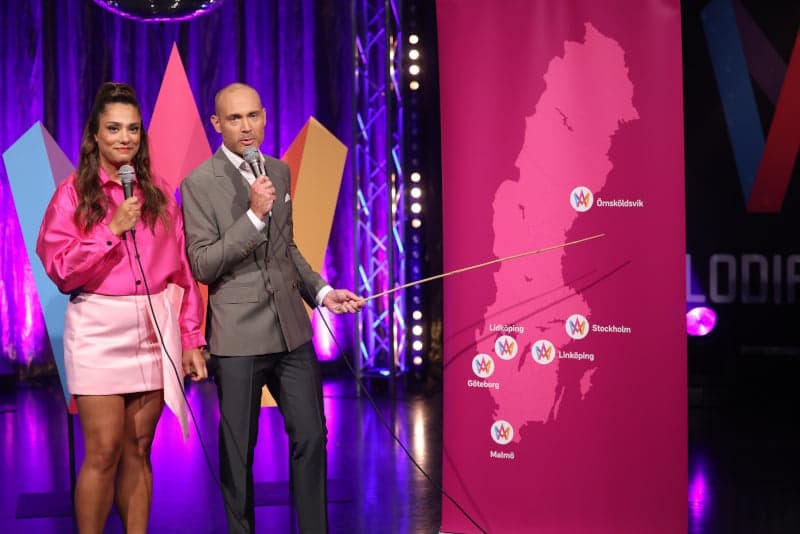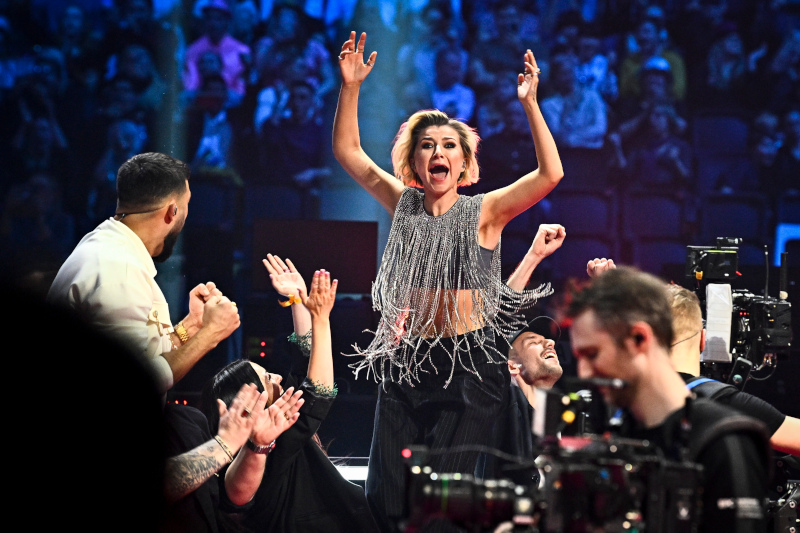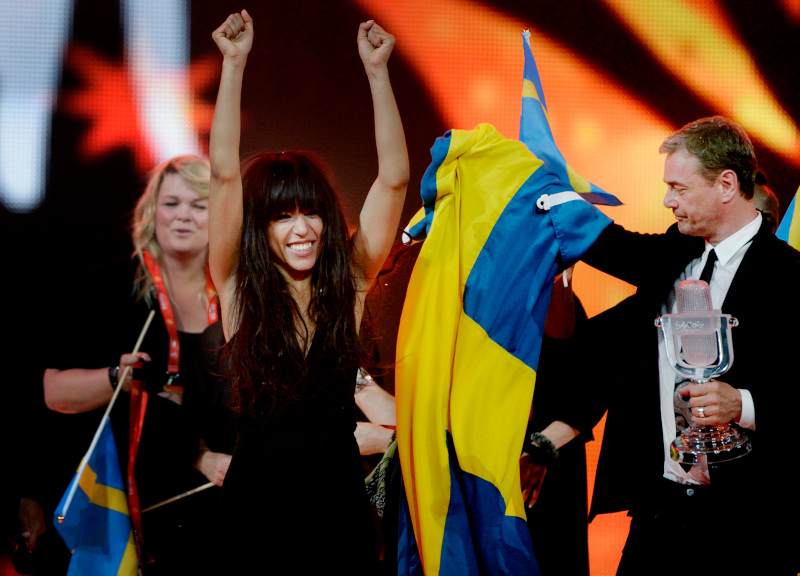How do you watch the Swedish extravaganza that is Melodifestivalen?

Here's a guide to what to expect from this year's Swedish tryouts for the Eurovision Song Contest, ranging from Sami tunes to chart-breaking pop anthems.
Congratulations for surviving the depths of winter. When the sky was at its darkest and the Christmas ham seemingly dominated every plate of food, hope and brightness was getting ever closer.
And now that the light is starting to return, so does the Swedish television tradition that trumps all others (ok maybe not Kalle Anka and his friends at Christmas), but it’s not far away. We are talking about the brightest and sparkliest show on the whole of Swedish TV that fills the void of these late winter days.
Welcome once more to Melodifestivalen.
The biggest selection in Europe
Melodifestivalen is the competition for Sweden to choose the song that will represent the country in the Eurovision Song Contest, the biggest entertainment show on Earth. Broadcasters from 37 countries as far afield as Azerbaijan, Iceland and... yes, Australia will compete in Liverpool this May for the prize of being the best song in Europe and bringing the show to their home country next year (or at least that is traditionally the plan, sadly the 2022 victors Ukraine are not able to host due to Russia’s invasion, and as thus the public broadcaster there is co-hosting with the BBC from the United Kingdom, who finished 2nd).
Sweden takes this Eurovision deal seriously. Melodifestivalen is a six week long extravaganza. Year upon year all six of these shows rank in the top ten of the Swedish television viewing figures. Not only that but you are sure-fire guaranteed to find a plethora of the 28 competing songs smashing the Swedish charts and being on radio airplay lists even months after the show disappeared from television.
But this isn’t just a thing appreciated by the Swedes. When it comes to Eurovision, Sweden is arguably the hottest country in the entire competition. Only twice in the last 12 years has Sweden finished outside of the Eurovision top 10, a record including four podium finishes and two first places. This track record means that the Melodifestivalen fanbase doesn’t just cover Swedes from the ages of 3 to 93, but also hundreds of Eurovision fans who make a pilgrimage to witness Melodifestivalen live in person each year and party all weekend long.
The popularity of the Swedish show is such that since 2013 the show’s finale has been held in the national football stadium of Friends Arena to an audience of nearly 30,000 spectators – a show on a scale many times more than most other competing countries.
Those two hours of musical entertainment are a highlight for the public broadcaster SVT, and have been the springboard for much of its talent to now work internationally. Former Executive Producer Martin Österdahl led the SVT team for the Eurovision hosting in Malmö in 2013 and in Stockholm three years later before taking the top job as Executive Supervisor of the entire Eurovision Song Contest in 2020.
That is in addition to the whole team of Swedes who went out last year to California to create the first ever American Song Contest featuring acts from every state and territory of the United States, a format that is even entering Canada later this year.

Cornelia Jakobs represented Sweden at Eurovision in 2022. Photo: Claudio Bresciani/TT
What can we expect this year?
All being well, the 2023 edition of Melodifestivalen will be the first since pandemic times when the TV spectacle has been able to tour the length and breadth of the country, with the heats before the final taking place in Gothenburg, Linköping, Lidköping and Malmö this year. Two songs from seven in each heat will qualify to the Grand Final in Friends Arena, and two others will head to the so-called Semi Final round, this year in northerly Örnsköldsvik, before we get the 12 songs that will compete for a place in the Eurovision Song Contest on Saturday 11th March.
And while Sweden might be the country best known for exporting pop music to the planet, expect all sorts of genres to be thrown at you. Look out in Saturday’s first heat from Gothenburg for tender ballads, sparkly pop tunes, Sami jojk and a clap-a-long duet by long loved Swedish icons Eva Rydberg and Ewa Roos with a combined age over 150. Whatever type of entertainment you are looking for from Saturday night programming, expect to find it here.
The biggest name in this year’s competition is Loreen, the 2012 winner of the Eurovision Song Contest with the smash hit Euphoria that packed out the dance floors and radio playlists all spring and summer across the continent. But SVT has decided we will have to wait until the final week to hear if the pre-show favourite has the song to head across to the United Kingdom in May.

Loreen won Eurovision in 2012. Photo: Jessica Gow/TT
Otherwise the expectation is that Norwegian twins Marcus and Martinus and 17-year-old Theoz are going to be the names on all the teenagers lips this year as both promises to bring both slick routines and catchy choruses to this festival of hit music. You have been warned.
Nestled within the pop music glitz and glamour though is the story of Maria Sur, herself 17 years of age and a refugee from Ukraine. The Local has already spoken to her about her journey from Ukraine to Sweden and now to the nation's biggest stage, and her song Never Give Up is certain to be a tearjerker.
How can I watch the circus?
Melodifestivalen is shown on Saturday nights at 8pm for six consecutive weeks on SVT1 or SVT Play, the broadcaster’s online streaming service. SVT Play will also offer an option to follow the English text commentary if you would like more explanation as the chaos unfolds each night. The show is also available on Sveriges Radio P4.
One can even jump straight into the deep end and purchase tickets for the arena shows around the country, with rehearsals on the Friday night as well as a Saturday matinee performance available as well as the live broadcast.
What you want to do either way is before the show get yourself loaded up with the Melodifestivalen app (Apple or Android). Create an account so that you can join the hundreds of thousands of Swedes in voting for your favourite songs using your phone absolutely free (pay options are also available, including one that donates money to Radiohjälpen).
And whether you watch it or you don’t, make sure to check in with the results and the songs before you return to work, because if there is one thing you can be sure of is that the conversation topic of the day will be if the right songs won or not.
Ben Robertson is also covering Melodifestivalen 2023 for ESC Insight.
Comments
See Also
Congratulations for surviving the depths of winter. When the sky was at its darkest and the Christmas ham seemingly dominated every plate of food, hope and brightness was getting ever closer.
And now that the light is starting to return, so does the Swedish television tradition that trumps all others (ok maybe not Kalle Anka and his friends at Christmas), but it’s not far away. We are talking about the brightest and sparkliest show on the whole of Swedish TV that fills the void of these late winter days.
Welcome once more to Melodifestivalen.
The biggest selection in Europe
Melodifestivalen is the competition for Sweden to choose the song that will represent the country in the Eurovision Song Contest, the biggest entertainment show on Earth. Broadcasters from 37 countries as far afield as Azerbaijan, Iceland and... yes, Australia will compete in Liverpool this May for the prize of being the best song in Europe and bringing the show to their home country next year (or at least that is traditionally the plan, sadly the 2022 victors Ukraine are not able to host due to Russia’s invasion, and as thus the public broadcaster there is co-hosting with the BBC from the United Kingdom, who finished 2nd).
Sweden takes this Eurovision deal seriously. Melodifestivalen is a six week long extravaganza. Year upon year all six of these shows rank in the top ten of the Swedish television viewing figures. Not only that but you are sure-fire guaranteed to find a plethora of the 28 competing songs smashing the Swedish charts and being on radio airplay lists even months after the show disappeared from television.
But this isn’t just a thing appreciated by the Swedes. When it comes to Eurovision, Sweden is arguably the hottest country in the entire competition. Only twice in the last 12 years has Sweden finished outside of the Eurovision top 10, a record including four podium finishes and two first places. This track record means that the Melodifestivalen fanbase doesn’t just cover Swedes from the ages of 3 to 93, but also hundreds of Eurovision fans who make a pilgrimage to witness Melodifestivalen live in person each year and party all weekend long.
The popularity of the Swedish show is such that since 2013 the show’s finale has been held in the national football stadium of Friends Arena to an audience of nearly 30,000 spectators – a show on a scale many times more than most other competing countries.
Those two hours of musical entertainment are a highlight for the public broadcaster SVT, and have been the springboard for much of its talent to now work internationally. Former Executive Producer Martin Österdahl led the SVT team for the Eurovision hosting in Malmö in 2013 and in Stockholm three years later before taking the top job as Executive Supervisor of the entire Eurovision Song Contest in 2020.
That is in addition to the whole team of Swedes who went out last year to California to create the first ever American Song Contest featuring acts from every state and territory of the United States, a format that is even entering Canada later this year.

What can we expect this year?
All being well, the 2023 edition of Melodifestivalen will be the first since pandemic times when the TV spectacle has been able to tour the length and breadth of the country, with the heats before the final taking place in Gothenburg, Linköping, Lidköping and Malmö this year. Two songs from seven in each heat will qualify to the Grand Final in Friends Arena, and two others will head to the so-called Semi Final round, this year in northerly Örnsköldsvik, before we get the 12 songs that will compete for a place in the Eurovision Song Contest on Saturday 11th March.
And while Sweden might be the country best known for exporting pop music to the planet, expect all sorts of genres to be thrown at you. Look out in Saturday’s first heat from Gothenburg for tender ballads, sparkly pop tunes, Sami jojk and a clap-a-long duet by long loved Swedish icons Eva Rydberg and Ewa Roos with a combined age over 150. Whatever type of entertainment you are looking for from Saturday night programming, expect to find it here.
The biggest name in this year’s competition is Loreen, the 2012 winner of the Eurovision Song Contest with the smash hit Euphoria that packed out the dance floors and radio playlists all spring and summer across the continent. But SVT has decided we will have to wait until the final week to hear if the pre-show favourite has the song to head across to the United Kingdom in May.

Otherwise the expectation is that Norwegian twins Marcus and Martinus and 17-year-old Theoz are going to be the names on all the teenagers lips this year as both promises to bring both slick routines and catchy choruses to this festival of hit music. You have been warned.
Nestled within the pop music glitz and glamour though is the story of Maria Sur, herself 17 years of age and a refugee from Ukraine. The Local has already spoken to her about her journey from Ukraine to Sweden and now to the nation's biggest stage, and her song Never Give Up is certain to be a tearjerker.
How can I watch the circus?
Melodifestivalen is shown on Saturday nights at 8pm for six consecutive weeks on SVT1 or SVT Play, the broadcaster’s online streaming service. SVT Play will also offer an option to follow the English text commentary if you would like more explanation as the chaos unfolds each night. The show is also available on Sveriges Radio P4.
One can even jump straight into the deep end and purchase tickets for the arena shows around the country, with rehearsals on the Friday night as well as a Saturday matinee performance available as well as the live broadcast.
What you want to do either way is before the show get yourself loaded up with the Melodifestivalen app (Apple or Android). Create an account so that you can join the hundreds of thousands of Swedes in voting for your favourite songs using your phone absolutely free (pay options are also available, including one that donates money to Radiohjälpen).
And whether you watch it or you don’t, make sure to check in with the results and the songs before you return to work, because if there is one thing you can be sure of is that the conversation topic of the day will be if the right songs won or not.
Ben Robertson is also covering Melodifestivalen 2023 for ESC Insight.
Join the conversation in our comments section below. Share your own views and experience and if you have a question or suggestion for our journalists then email us at [email protected].
Please keep comments civil, constructive and on topic – and make sure to read our terms of use before getting involved.
Please log in here to leave a comment.